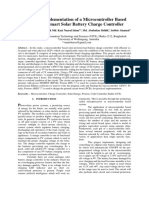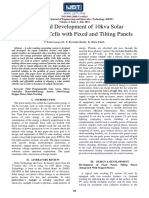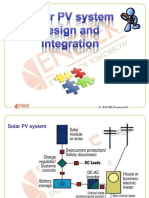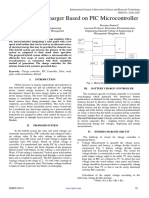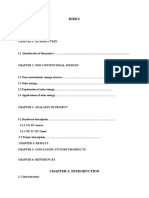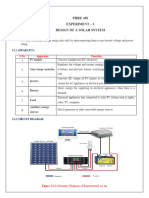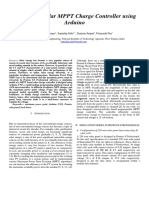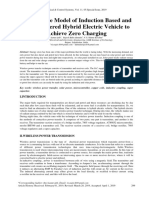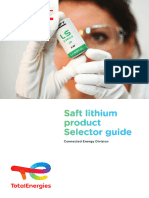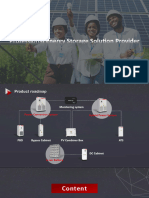Professional Documents
Culture Documents
Design and Development of Cost-Effective Solar Rechargeable Led Lantern
Copyright
Available Formats
Share this document
Did you find this document useful?
Is this content inappropriate?
Report this DocumentCopyright:
Available Formats
Design and Development of Cost-Effective Solar Rechargeable Led Lantern
Copyright:
Available Formats
Volume 6, Issue 3, March – 2021 International Journal of Innovative Science and Research Technology
ISSN No:-2456-2165
Design and Development of Cost-Effective Solar
Rechargeable Led Lantern
Azubuike Aniedu1, Azubogu A.C.O2, Ufoaroh S.U3, Obioma Peace Chibueze4
1,2,3,4
Department of Electronic and Computer Engineering
Nnamdi Azikiwe University
Awka, Nigeria
Abstract:- In many countries of sub-Saharan Africa performance of the fixture after being used for a short period.
including Nigeria, more than 70% of the people live in In many instances, users of the solar lanterns end up
off-grid communities where they depend on kerosene discarding them after few months of usage because they lack
hurricane lanterns and candles to light their homes and access to affordable spare parts.
batteries for their torches and radios. Battery charging
using portable generating set is an increasingly common Based on the results of technical analysis of selected
service in these communities. The fume from the solar rechargeable lanterns and general discussions with
generating sets and from burning kerosene and candle is users, some important features were considered and they
toxic and lead to respiratory illnesses over time. For include:
most people in this setting, their living conditions could Lantern should provide white light equivalent to the
be improved simply by providing cost effective output of a 15 Watt CFL for up to 6 hours every day
renewable energy power sources that would power LED The lighting fixture should be able to cover a 360 degree
lamps, radio sets and other electronic appliances. It is spread of light
the goal of this project to develop affordable solar The lighting fixture will be portable with a good base
lantern kit for use in rural households in Nigeria. The The lighting fixture shield should will be translucent with
solar lantern kit consists of an 8-W solar panel, 2 light minimum dispersion effects
sources consisting of high efficiency LED lamp capable The fixture will also have a charging indicator to indicate
of producing 6-hours of light of ≥ 800 lumen each, and a charging, and under-discharge light to indicate that the
charge control circuit capable of fully charging 2 battery is low.
rechargeable 3.7V lithium-ion batteries in 6 hours of An auxiliary socket for powering small electronic devices
direct sunlight using the external 8-W solar panel. with minimal power rating.
Keywords:- Rechargeable Lamptern; Solar; LED; Styling; II. DESIGN PARAMETERS
Insert.
It is the aim of this research to develop a solar
I. INTRODUCTION rechargeable lantern kit capable of producing 6-hours of
light of ≥800 lumen, and a charge control circuit capable of
In many countries of sub-Saharan Africa, more than fully charging 2 rechargeable 3.7V lithium-ion batteries in 6
70% of the people are off grid. The situation is even worst hours of direct sunlight using 8-W solar panel.
for rural areas where about 95% of the populace are without
electrical power supply. Largely, the people depend on Table 1: Design parameters for the proposed Solar
kerosene and candles for lighting, and batteries for small rechargeable lamp
appliances [1]. For instance, in a country like Nigeria, more
than 120 million people are without access to electricity,
consequently leading to the use of costly and even harmful
energy sources [2].
Successive World Bank surveys have always shown the
prospects for decentralized power supplies for lighting, both
at community and household level in these countries [1]. The major goal of this project is to develop an
These studies showed that solar rechargeable lanterns are an improved and cost-effective solar rechargeable LED-based
affordable, environmentally-friendly, and portable lighting lantern as an alternative solution for kerosene lamps. This
option for large sections of the rural communities in these demands developing specific characteristics to exceed that
countries. However, despite the growing interest in solar of those available in the market. The proposed solar lighting
lantern, available products in Nigerian market are imported fixture consists of a PV module, which provides solar
and highlighted a number of technical shortcomings. The energy; a rechargable Lithium Ion battery for storing
shortfalls often highlighted include inferior construction of energy; a charge controller to control charging rate of the
the lighting fixture, poor illuminance, and the relatively poor battery so as to prevent over-charging; auxiliary supply
IJISRT21MAR469 www.ijisrt.com 1168
Volume 6, Issue 3, March – 2021 International Journal of Innovative Science and Research Technology
ISSN No:-2456-2165
socket to power small appliances; LED’s and the LED
driver.
III. DESIGN FLOW
The design flow process of all the segments of this
research is as shown in the block diagrams below:
Figure 3: Current vs Voltage curve of Li-ion battery [3]
The block diagram of the Pulse Width Modulated
(PWM) charge controller is shown in Figure 2. The DC
source (an 8 watts PV panel) provides power to charge the
Figure 2: Block Diagram of the entire process Li-ion cell, as well as power the PWM generator circuit. The
power switch is a power transistor switched by the high
frequency PWM pulses from the PWM Generator. The
Voltage Monitor monitors the terminal voltage of the Li-Ion
cell, when the terminal voltage gets to 4.2V (Full Charge
voltage of the Li-Ion cell), it sends a short-off signal to the
PWM generator, stopping the charging process. The flow of
electricity is regulated by the charge controller as power
flows from the PV modules to the battery and the load. The
charge controller prevents the battery from being over
Figure 3: Design process of Circuit board charged after being fully charged. During the charging
process, as soon as the controller senses that the battery is
fully charged, it will stop the flow of charge from the
modules.
The charge controller is based on TL494, it houses in a
single chip, most of the features required to construct of a
pulse-width modulation (PWM) control circuit. It contains
Figure 4: Design process of Casein two error amplifiers, an adjustable oscillator embedded on
the chip, a dead-time control (DTC) comparator, a pulse-
steering control flip-flop, a 5-V, 5%-precision regulator, and
output-control circuits [4].
Figure 5: Design process of Diffuser During operation, the oscillator helps to provide a
positive saw tooth waveform to both the dead-time and
PWM comparators to enable comparison of the various
control signals. To program the frequency of the oscillator,
the timing components RT and CT are altered. The external
Figure 6: Complete Design process
timing capacitor (CT) is charged by the oscillator with a
constant current. This value is determined by the external
IV. SYSTEM DESCRIPTION
timing resistor, RT. This produces a linear-ramp voltage
waveform. When the voltage across CT reaches 3 V, the
The Li ion charger designed for this system is a
oscillator circuit discharges it, and the charging cycle is
voltage-limiting device and is similar to the charging system
reinitiated.
of a lead acid. They are some differences between the two
systems; Li-ion has a higher voltage per cell, alongside a
To enable modulation control of the output pulse, the
tighter voltage tolerances. Li-ion cells are designed in such a
comparator is employed. To achieve this, the control signal
way that they follow the correct settings placed by the
at the error amplifiers is compared to the ramp voltage
manufacturers, because Li-ion cannot accept overcharge.
across the timing capacitor CT. A diode is connected in
Charging a Li-ion battery consists of three stages: pre-
series with the timing capacitor and it is usually omitted
charging stage (slow charging), constant current charge (fast
from the control signal input. When the error amplifier
charge) and constant voltage charging stage [3]. Figure 7
output signal is approximately 0.7 V greater than the voltage
shows a plot of the current vs voltage curve of the Li-ion
across CT, it will inhibit the output logic. This connection
battery.
helps to ensure that the it gets to maximum duty cycle
IJISRT21MAR469 www.ijisrt.com 1169
Volume 6, Issue 3, March – 2021 International Journal of Innovative Science and Research Technology
ISSN No:-2456-2165
operation without requiring the control voltage to sink to a The circuit printed circuit board is as shown in figure 9.
true ground potential [4]. As the voltage of the error
amplifier output varies from 0.5 V to 3.5 V, the output pulse
width varies from 97% of the period to 0 respectively. The
circuit diagram of the system is as shown in figure 8:
Figure 9: Circuit PCB
V. CONCLUSION
Figure 8: Circuit diagram of the TL494 circuitry In this paper, a solar powered lantern kit consisting of
an 8-W solar panel with 2 rechargeable 3.7V lithium-ion
The power supply range of the TL494 is between 7 V batteries and LED luminaires has been designed. The system
and 40 V which is usually regulated properly [4]. A bulk is capable of producing a luminance value greater than or
capacitance alongside a ceramic bypass capacitor is required equal to 800 lumens. The charge controller unit circuit
to be added to the circuit if the power supply is located some designed is capable of fully charging 2 rechargeable 3.7V
inches away from the device. In this design, a 47 μF tantalum lithium-ion batteries in 6 hours of direct sunlight using the
capacitor was used. A low EMI inductor with a ferrite type external 8-W solar panel.
closed core was used. Since the ceramic input filter capacitor
has a low value, it was located very close to the VCC pin of ACKNOWLEDGMENT
the IC. This helps to reduce the inductance effects to as much
lower value as possible. This provides a cleaner voltage This project is being done under the Tertiary Education
supply to the internal IC rail. Trust Fund (TETFund) Institution Based Research Fund
(IBRF). The support of TETFund is immensely appreciated.
To determine the size of the inductor (L), the following The authors would like to thank all the staff of Electronics
calculation was done: Lab, ECE department, Nnamdi Azikiwe University..
d = duty cycle = VO/VI = 5 V/32 V = 0.156
f = 20 kHz (design objective) REFERENCES
ton = time on (S1 closed) = (1/f) × d = 7.8 μs
toff = time off (S1 open) = (1/f) – ton = 42.2 μs [1]. Moussa P. Blimpo and Malcolm Cosgrove-Davies,
L ≉ (VI – VO) × ton/ΔIL “Electricity Access in Sub-Saharan Africa: Uptake,
≉ [(32 V – 5 V) × 7.8 μs]/1.5 A Reliability, and Complementary Factors for Economic
≉ 140.4 μH Impact, International Bank for Reconstruction and
Development / The World Bank, 2019, DOI:
After calculating the value of the filter inductor, the 10.1596/978-1-4648-1361-0.
value of the output filter capacitor is selected to match the [2]. Kayode Olaniyan, Benjamin C. McLellan ID , Seiichi
requirement of the output ripple. Ogata and Tetsuo Tezuka, “Estimating Residential
Electricity Consumption in Nigeria to Support Energy
The design also monitors the battery temperature of the Transitions”, MDPI sustainability, May 2018.
device using an NTC (Negative Temperature Co-efficient) [3]. AnnaTomaszewska, Zhengyu Chu, Xuning Feng,
thermistor. To monitor the temperature, a 10kΩ, B = 3380 Simon O'Kane, Xinhua Liu, Jingyi Chen, Chenzhen Ji,
NTC thermistor is connected from the NTC pin to ground. et al, “Lithium-ion battery fast charging: A review”,
This pin monitors the voltage dropped across the 10kΩ eTransportation, Volume 1, 2019, 100011, ISSN2590-
thermistor and sources about 50μA. During operation, when 1168.
the voltage on the NTC pin is above 1.36V (0°C) or below [4]. Tl494 Datasheet, available online
0.29V (40°C), the temperature of the battery is considered to www.alldatasheet.com/tl494. Accessed 23 July, 2019
be out of range. When this happens, the circuit will indicate [5]. EE power, available online
an NTC fault. The triggered fault condition would remain https://eepower.com/resistor-guide/resistor-types/ntc-
except the voltage on the NTC pin falls within the range of thermistor/#. Accessed on 28th , July, 2019.
0°C to 40°C [5].
IJISRT21MAR469 www.ijisrt.com 1170
You might also like
- Microcontroller-Based Solar Charge Controller DesignDocument4 pagesMicrocontroller-Based Solar Charge Controller DesignolumideNo ratings yet
- Solar Power Wireless Battery ChargerDocument18 pagesSolar Power Wireless Battery ChargerClassic PrintersNo ratings yet
- Solar Charge Controller Circuit Working With Microcontroller PDF FreeDocument12 pagesSolar Charge Controller Circuit Working With Microcontroller PDF FreeHrishikesh BhatNo ratings yet
- Microcontroller Based 12V-7A/10A Smart Solar Battery Charge ControllerDocument5 pagesMicrocontroller Based 12V-7A/10A Smart Solar Battery Charge ControllerBruno PilzNo ratings yet
- Design and Implementation of Solar Based DC Grid Using Arduino UnoDocument5 pagesDesign and Implementation of Solar Based DC Grid Using Arduino UnoMobeenNo ratings yet
- Study of Solar Ups For Design, Illustrate & Commssioning of Smart Inverter Based Ups at Eee DepartmentDocument4 pagesStudy of Solar Ups For Design, Illustrate & Commssioning of Smart Inverter Based Ups at Eee DepartmentAnam SheikhNo ratings yet
- International Journal of Academic Research and Development Solar Charge ControllerDocument8 pagesInternational Journal of Academic Research and Development Solar Charge ControllerShreyash Samir KankalNo ratings yet
- Projectreport REDocument15 pagesProjectreport REUnzillahNo ratings yet
- Energy ManagementDocument55 pagesEnergy ManagementNjitnumNo ratings yet
- Maximizing Solar Energy Collection Through TrackingDocument3 pagesMaximizing Solar Energy Collection Through Trackingtakethebow runNo ratings yet
- Solar Powered Mobile Power Bank SystemDocument4 pagesSolar Powered Mobile Power Bank SystemRidhwan FirdausNo ratings yet
- Solar Charge Controller Using MicrocontrollerDocument8 pagesSolar Charge Controller Using MicrocontrollerNikhil PottabathiniNo ratings yet
- Implementation of Three-Phase Grid Connected Inverter For Photovoltaic Solar Power Generation System-With-Cover-Page-V2Document5 pagesImplementation of Three-Phase Grid Connected Inverter For Photovoltaic Solar Power Generation System-With-Cover-Page-V2Lenowahira DillemanowaryNo ratings yet
- 5 Solar PV DesignDocument63 pages5 Solar PV DesignDavid EspinosaNo ratings yet
- Chapter One 1.0 BackgroundDocument41 pagesChapter One 1.0 BackgroundPeter DindahNo ratings yet
- Calculation of Electrical Energy With SolarDocument4 pagesCalculation of Electrical Energy With Solarmohamed parvez100% (1)
- Building of A Portable Solar AC & DC Power SupplyDocument7 pagesBuilding of A Portable Solar AC & DC Power Supplygundam busterNo ratings yet
- Solar Power Bank With Wireless ChargingDocument4 pagesSolar Power Bank With Wireless ChargingEditor IJTSRDNo ratings yet
- Automated Switching Solar Power Grid Tie Inverter Using Embedded SystemDocument5 pagesAutomated Switching Solar Power Grid Tie Inverter Using Embedded SystemBONFRINGNo ratings yet
- Smart Hybrid Charger Based On PIC MicrocontrollerDocument3 pagesSmart Hybrid Charger Based On PIC MicrocontrollerInternational Journal of Innovative Science and Research TechnologyNo ratings yet
- Solar Charge Controller with Data Acquisition System Based on ArduinoDocument9 pagesSolar Charge Controller with Data Acquisition System Based on ArduinoolumideNo ratings yet
- RP Report New SecondDocument10 pagesRP Report New SecondElectrio MurmuNo ratings yet
- Super Capacitor To Enhance Charging Performance of Solar PV SystemDocument6 pagesSuper Capacitor To Enhance Charging Performance of Solar PV SystemIJRASETPublicationsNo ratings yet
- Yaman PaperDocument6 pagesYaman PaperAkbar aliNo ratings yet
- InverterDocument23 pagesInverterBittu Kumar SinhaNo ratings yet
- UiTM FYP Full Report PogressDocument15 pagesUiTM FYP Full Report PogressImran Shazilly50% (2)
- Real Time Performance Monitoring of Solar PanelDocument12 pagesReal Time Performance Monitoring of Solar PanelKaushik DasNo ratings yet
- Jennifer New Project (Correction)Document25 pagesJennifer New Project (Correction)HASTINGS EMURASHENo ratings yet
- Design and develop instant power supplyDocument5 pagesDesign and develop instant power supplySourav Das ShuvoNo ratings yet
- Matecconf Ses2018 06006Document6 pagesMatecconf Ses2018 06006Rendell Honey LeybaNo ratings yet
- Real-Time Battery Monitoring System For Solar InfrastructureDocument5 pagesReal-Time Battery Monitoring System For Solar InfrastructureTeki Vamsee KrishnaNo ratings yet
- Hybrid Power Generation SlideDocument23 pagesHybrid Power Generation SlideCnp1 Cnp1No ratings yet
- Dodatak BDocument3 pagesDodatak Bmonalester CruzNo ratings yet
- Implementation of Three Phase Grid ConneDocument4 pagesImplementation of Three Phase Grid ConneMBA Library, RR Campus,PESUNo ratings yet
- Design and Implementation of A Solar Charge Controller With Variable OutputDocument12 pagesDesign and Implementation of A Solar Charge Controller With Variable OutputEmmanuel SundayNo ratings yet
- Development of Bidirectional Net Meter in Grid Connected Solar PV System For Domestic ConsumersDocument5 pagesDevelopment of Bidirectional Net Meter in Grid Connected Solar PV System For Domestic ConsumersHariprasad RNo ratings yet
- SolarDocument12 pagesSolarsama karthikNo ratings yet
- Group1 Battery ChargerDocument18 pagesGroup1 Battery ChargerNguyễn Nam AnhNo ratings yet
- CHAPTER 3 TECHNICAL ASPECT Solar Powered GeneratorDocument47 pagesCHAPTER 3 TECHNICAL ASPECT Solar Powered GeneratorRed SecretarioNo ratings yet
- Solar Street Light Project ReportDocument27 pagesSolar Street Light Project ReportVinod JadavNo ratings yet
- Solar Powered Phone ChargerrrrrrrrrrrrrrrrrrrrrrrrrrrrDocument14 pagesSolar Powered Phone Chargerrrrrrrrrrrrrrrrrrrrrrrrrrrrkalu chimdiNo ratings yet
- PHRE 450 Lab ManualDocument6 pagesPHRE 450 Lab Manualsamuelnyaruai628No ratings yet
- Solar Night Light AssemblyDocument14 pagesSolar Night Light AssemblyYamut Si akoNo ratings yet
- Low Power Inverter Design and ApplicationsDocument39 pagesLow Power Inverter Design and ApplicationsNarendhar MudavathNo ratings yet
- Design and Implementation of A Solar Charge Controller With Variable OutputDocument12 pagesDesign and Implementation of A Solar Charge Controller With Variable OutputManish kumar100% (1)
- Zeta PDFDocument5 pagesZeta PDFCrispNo ratings yet
- Solar MPPT Battery Charger For The Rural Electrification SystemDocument36 pagesSolar MPPT Battery Charger For The Rural Electrification SystemtombalakNo ratings yet
- RP Report New ThirdDocument9 pagesRP Report New ThirdElectrio MurmuNo ratings yet
- Solar Energy Measurement Using ArduinoDocument6 pagesSolar Energy Measurement Using ArduinoMihai BogdanNo ratings yet
- Design of a Solar MPPT Charge Controller using ArduinoDocument8 pagesDesign of a Solar MPPT Charge Controller using ArduinoWojtekNo ratings yet
- 4.research Paper TypedDocument18 pages4.research Paper TypedDadaNo ratings yet
- Buck-Boost Converter Implementation for Remote Area LED LightingDocument4 pagesBuck-Boost Converter Implementation for Remote Area LED LightingSingam SridharNo ratings yet
- Project: Solar Powered Induction Motor DriveDocument75 pagesProject: Solar Powered Induction Motor DriveDebanjan ChatterjeeNo ratings yet
- SolarPoweredMobile AJEEEDocument5 pagesSolarPoweredMobile AJEEEJohnzNo ratings yet
- Design a BMS with automatic cutoff for LiFePO4 batteriesDocument10 pagesDesign a BMS with automatic cutoff for LiFePO4 batteriesyasvanthkumar sNo ratings yet
- A Prototype Model of Induction Based and Solar Powered Hybrid Electric Vehicle To Achieve Zero ChargingDocument7 pagesA Prototype Model of Induction Based and Solar Powered Hybrid Electric Vehicle To Achieve Zero Chargingchokkakulasagar1810No ratings yet
- Implementation of Solar Tracking Mechanism Based On Mobile PV PanelDocument4 pagesImplementation of Solar Tracking Mechanism Based On Mobile PV PanelIJARTETNo ratings yet
- Hybrid Solar Inverter: Project Guide MR - Vishwaprakash BabuDocument12 pagesHybrid Solar Inverter: Project Guide MR - Vishwaprakash BabuKalyan Reddy AnuguNo ratings yet
- Compact and Wearable Ventilator System for Enhanced Patient CareDocument4 pagesCompact and Wearable Ventilator System for Enhanced Patient CareInternational Journal of Innovative Science and Research TechnologyNo ratings yet
- Insights into Nipah Virus: A Review of Epidemiology, Pathogenesis, and Therapeutic AdvancesDocument8 pagesInsights into Nipah Virus: A Review of Epidemiology, Pathogenesis, and Therapeutic AdvancesInternational Journal of Innovative Science and Research TechnologyNo ratings yet
- Implications of Adnexal Invasions in Primary Extramammary Paget’s Disease: A Systematic ReviewDocument6 pagesImplications of Adnexal Invasions in Primary Extramammary Paget’s Disease: A Systematic ReviewInternational Journal of Innovative Science and Research TechnologyNo ratings yet
- Smart Cities: Boosting Economic Growth through Innovation and EfficiencyDocument19 pagesSmart Cities: Boosting Economic Growth through Innovation and EfficiencyInternational Journal of Innovative Science and Research TechnologyNo ratings yet
- Air Quality Index Prediction using Bi-LSTMDocument8 pagesAir Quality Index Prediction using Bi-LSTMInternational Journal of Innovative Science and Research TechnologyNo ratings yet
- An Analysis on Mental Health Issues among IndividualsDocument6 pagesAn Analysis on Mental Health Issues among IndividualsInternational Journal of Innovative Science and Research TechnologyNo ratings yet
- The Making of Object Recognition Eyeglasses for the Visually Impaired using Image AIDocument6 pagesThe Making of Object Recognition Eyeglasses for the Visually Impaired using Image AIInternational Journal of Innovative Science and Research TechnologyNo ratings yet
- Harnessing Open Innovation for Translating Global Languages into Indian LanuagesDocument7 pagesHarnessing Open Innovation for Translating Global Languages into Indian LanuagesInternational Journal of Innovative Science and Research TechnologyNo ratings yet
- Parkinson’s Detection Using Voice Features and Spiral DrawingsDocument5 pagesParkinson’s Detection Using Voice Features and Spiral DrawingsInternational Journal of Innovative Science and Research TechnologyNo ratings yet
- Dense Wavelength Division Multiplexing (DWDM) in IT Networks: A Leap Beyond Synchronous Digital Hierarchy (SDH)Document2 pagesDense Wavelength Division Multiplexing (DWDM) in IT Networks: A Leap Beyond Synchronous Digital Hierarchy (SDH)International Journal of Innovative Science and Research TechnologyNo ratings yet
- Investigating Factors Influencing Employee Absenteeism: A Case Study of Secondary Schools in MuscatDocument16 pagesInvestigating Factors Influencing Employee Absenteeism: A Case Study of Secondary Schools in MuscatInternational Journal of Innovative Science and Research TechnologyNo ratings yet
- Exploring the Molecular Docking Interactions between the Polyherbal Formulation Ibadhychooranam and Human Aldose Reductase Enzyme as a Novel Approach for Investigating its Potential Efficacy in Management of CataractDocument7 pagesExploring the Molecular Docking Interactions between the Polyherbal Formulation Ibadhychooranam and Human Aldose Reductase Enzyme as a Novel Approach for Investigating its Potential Efficacy in Management of CataractInternational Journal of Innovative Science and Research TechnologyNo ratings yet
- Comparatively Design and Analyze Elevated Rectangular Water Reservoir with and without Bracing for Different Stagging HeightDocument4 pagesComparatively Design and Analyze Elevated Rectangular Water Reservoir with and without Bracing for Different Stagging HeightInternational Journal of Innovative Science and Research TechnologyNo ratings yet
- The Relationship between Teacher Reflective Practice and Students Engagement in the Public Elementary SchoolDocument31 pagesThe Relationship between Teacher Reflective Practice and Students Engagement in the Public Elementary SchoolInternational Journal of Innovative Science and Research TechnologyNo ratings yet
- Diabetic Retinopathy Stage Detection Using CNN and Inception V3Document9 pagesDiabetic Retinopathy Stage Detection Using CNN and Inception V3International Journal of Innovative Science and Research TechnologyNo ratings yet
- The Utilization of Date Palm (Phoenix dactylifera) Leaf Fiber as a Main Component in Making an Improvised Water FilterDocument11 pagesThe Utilization of Date Palm (Phoenix dactylifera) Leaf Fiber as a Main Component in Making an Improvised Water FilterInternational Journal of Innovative Science and Research TechnologyNo ratings yet
- Advancing Healthcare Predictions: Harnessing Machine Learning for Accurate Health Index PrognosisDocument8 pagesAdvancing Healthcare Predictions: Harnessing Machine Learning for Accurate Health Index PrognosisInternational Journal of Innovative Science and Research TechnologyNo ratings yet
- Auto Encoder Driven Hybrid Pipelines for Image Deblurring using NAFNETDocument6 pagesAuto Encoder Driven Hybrid Pipelines for Image Deblurring using NAFNETInternational Journal of Innovative Science and Research TechnologyNo ratings yet
- Formulation and Evaluation of Poly Herbal Body ScrubDocument6 pagesFormulation and Evaluation of Poly Herbal Body ScrubInternational Journal of Innovative Science and Research TechnologyNo ratings yet
- Electro-Optics Properties of Intact Cocoa Beans based on Near Infrared TechnologyDocument7 pagesElectro-Optics Properties of Intact Cocoa Beans based on Near Infrared TechnologyInternational Journal of Innovative Science and Research TechnologyNo ratings yet
- Terracing as an Old-Style Scheme of Soil Water Preservation in Djingliya-Mandara Mountains- CameroonDocument14 pagesTerracing as an Old-Style Scheme of Soil Water Preservation in Djingliya-Mandara Mountains- CameroonInternational Journal of Innovative Science and Research TechnologyNo ratings yet
- Explorning the Role of Machine Learning in Enhancing Cloud SecurityDocument5 pagesExplorning the Role of Machine Learning in Enhancing Cloud SecurityInternational Journal of Innovative Science and Research TechnologyNo ratings yet
- The Impact of Digital Marketing Dimensions on Customer SatisfactionDocument6 pagesThe Impact of Digital Marketing Dimensions on Customer SatisfactionInternational Journal of Innovative Science and Research TechnologyNo ratings yet
- Navigating Digitalization: AHP Insights for SMEs' Strategic TransformationDocument11 pagesNavigating Digitalization: AHP Insights for SMEs' Strategic TransformationInternational Journal of Innovative Science and Research Technology100% (1)
- A Survey of the Plastic Waste used in Paving BlocksDocument4 pagesA Survey of the Plastic Waste used in Paving BlocksInternational Journal of Innovative Science and Research TechnologyNo ratings yet
- Design, Development and Evaluation of Methi-Shikakai Herbal ShampooDocument8 pagesDesign, Development and Evaluation of Methi-Shikakai Herbal ShampooInternational Journal of Innovative Science and Research Technology100% (3)
- A Review: Pink Eye Outbreak in IndiaDocument3 pagesA Review: Pink Eye Outbreak in IndiaInternational Journal of Innovative Science and Research TechnologyNo ratings yet
- Cyberbullying: Legal and Ethical Implications, Challenges and Opportunities for Policy DevelopmentDocument7 pagesCyberbullying: Legal and Ethical Implications, Challenges and Opportunities for Policy DevelopmentInternational Journal of Innovative Science and Research TechnologyNo ratings yet
- Hepatic Portovenous Gas in a Young MaleDocument2 pagesHepatic Portovenous Gas in a Young MaleInternational Journal of Innovative Science and Research TechnologyNo ratings yet
- Automatic Power Factor ControllerDocument4 pagesAutomatic Power Factor ControllerInternational Journal of Innovative Science and Research TechnologyNo ratings yet
- The Mechanisms of Lithium and Sodium Insertion in Carbon MaterialsDocument9 pagesThe Mechanisms of Lithium and Sodium Insertion in Carbon MaterialsragulaceNo ratings yet
- Testing Lucas Voltage Regulators (Triumph)Document4 pagesTesting Lucas Voltage Regulators (Triumph)caldasferreirasoutoNo ratings yet
- Detroit Series 60 Operation ManualDocument154 pagesDetroit Series 60 Operation Manuallatranca100% (4)
- SE-3000 - Schumacher ElectricDocument3 pagesSE-3000 - Schumacher ElectricAlex RamirezNo ratings yet
- Battery and ChargerDocument72 pagesBattery and ChargerlrpatraNo ratings yet
- Electric Car Solar Cells PDFDocument94 pagesElectric Car Solar Cells PDFShazeb KhanNo ratings yet
- (English) Tesla Motors - Elon Musk - Documentary 2020 (DownSub - Com)Document39 pages(English) Tesla Motors - Elon Musk - Documentary 2020 (DownSub - Com)HhfvNo ratings yet
- Sales Forecast and Pricing Strategy Impact on Battery BusinessDocument11 pagesSales Forecast and Pricing Strategy Impact on Battery BusinessMuhammad Izzudin Kurnia Adi100% (1)
- User Manual Rish Insu 10Document10 pagesUser Manual Rish Insu 10Manoj TyagiNo ratings yet
- 1PM3-NLA Operating Instruction Manual V1Document20 pages1PM3-NLA Operating Instruction Manual V1Deany ArdianNo ratings yet
- Electrical VehiclesDocument16 pagesElectrical VehiclesDr. Gopinath SNo ratings yet
- GMRS Two Way Radio UV-9G Setup GuideDocument46 pagesGMRS Two Way Radio UV-9G Setup GuideMarco TauferNo ratings yet
- Hyster J40xnt Parts and Service Periodic Maintenance 1689720 8000SRM1339 (02 2012) US ENDocument80 pagesHyster J40xnt Parts and Service Periodic Maintenance 1689720 8000SRM1339 (02 2012) US ENJahir FrutosNo ratings yet
- User Guide Samsung L700 User Guide EnglishDocument78 pagesUser Guide Samsung L700 User Guide Englishmaccas3757No ratings yet
- SAFT Pilas Lithium (Selector Guide)Document16 pagesSAFT Pilas Lithium (Selector Guide)hansonsolovinoNo ratings yet
- Mastering Essay Question in Paper 3Document9 pagesMastering Essay Question in Paper 3Orkid Fazz70% (10)
- Truly Wireless Lancube HC-S0362 HC-S0362 Operation Book Wireless HeadphonesDocument6 pagesTruly Wireless Lancube HC-S0362 HC-S0362 Operation Book Wireless HeadphonesMandragora officinarum100% (1)
- ATESS ESS Products PresentationDocument54 pagesATESS ESS Products PresentationAlfredo LechinNo ratings yet
- Final Report. PBL PrintDocument19 pagesFinal Report. PBL PrintVaishnavi DakeNo ratings yet
- OPzS Installation & Operating InstructionsDocument3 pagesOPzS Installation & Operating InstructionskommuNo ratings yet
- Cardiac Pacemakers A Basic ReviewDocument11 pagesCardiac Pacemakers A Basic ReviewMuhammad Dilawar khanNo ratings yet
- Fresenius Pilote A2 - User Manual PDFDocument16 pagesFresenius Pilote A2 - User Manual PDFFillNo ratings yet
- Sonnenschein Lithium HC Modules for Advanced Energy SystemsDocument8 pagesSonnenschein Lithium HC Modules for Advanced Energy Systemsabdel jabbarNo ratings yet
- Tehnicki Opis 8251Document14 pagesTehnicki Opis 8251mikcomiNo ratings yet
- Anomalous Behavior During Low Rate Discharge of LiDocument10 pagesAnomalous Behavior During Low Rate Discharge of LiHuynhiemquoc80No ratings yet
- Fastview Installation and User Guide: Software Version 6.3Document227 pagesFastview Installation and User Guide: Software Version 6.3rao jayNo ratings yet
- Master List of QuantitiesDocument5 pagesMaster List of QuantitiesVKGNo ratings yet
- Cordless Hammer Drill ManualDocument64 pagesCordless Hammer Drill ManualTjell KeunNo ratings yet
- EPS PS835 CMM Rev. B 2009Document114 pagesEPS PS835 CMM Rev. B 2009juanpgutierrez100% (2)
- LAMAX E-Scooter S11600 WebDocument54 pagesLAMAX E-Scooter S11600 WebtomasNo ratings yet





